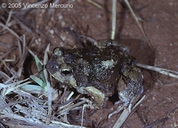|
Description
M 31-40 mm, F 36-42 mm. Head very short and tip of snout relatively rounded. No sharp dorsolateral colour border. Tympanum indistinct. Tibiotarsal articulation reaches insertion of forelimb or tympanum. Tips of fingers and toes not enlarged. Skin slightly to strongly granular. Colouration variable, usually light brown with different brown and black markings. Greenish colouration may occasionally occur. Venter white, sometimes with black spots (Glaw and Vences 2007). Distribution and Habitat
Country distribution from AmphibiaWeb's database: Madagascar
Occurs at Ambovombe, Behara, Belo, Berenty, Betanty, Bevato, Esomony, Horombe, Ifaty, Kirindy, Manambolo river near Esomony, Ranohira, Toliara, Vohibasia forest (Glaw and Vences 2007) from sea level up to 800 m asl in Madagascar (Glaw and Raxworthy 2008).Life History, Abundance, Activity, and Special Behaviors
Habits: In dry open areas in southern and south-western Madagascar. Males call on the borders of temporary ponds and puddles. Small eggs are laid and float on the surface. Tadpoles complete their development in the ponds (Glaw and Vences 2007). Explosive breeders that is characteristic of this genus (Scherz et al 2021).
Calls: A series of loud and relatively long notes which are unharmonious (Glaw and Vences 2007).
Trends and Threats
This species is listed as least concern because of its wide distribution, tolerance of a broad range of habitats, presumed large population, and because it is unlikely to be declining fast enough to qualify for listing in a more threatened category (Glaw and Raxworthy 2008). It occurs in many protected areas and is probably not affected by deforestation, and is adaptable and is unlikely to be threatened (Glaw and Raxworthy 2008). Comments
Original account from Glaw and Vences (2007) and Glaw and Raxworthy (2008) with permission.
Scherz et al (2021) synonomized Scaphiophryne verrucosa with S. brevis within the S. calcarata complex.
References
Glaw, F. and Raxworthy, C. (2008). Scaphiophryne brevis. In: IUCN 2008. 2008 IUCN Red List of Threatened Species. www.iucnredlist.org. Downloaded on 08 April 2009.
Glaw, F., and Vences, M. (2007). Field Guide to the Amphibians and Reptiles of Madagascar. Third Edition. Vences and Glaw Verlag, Köln.
Scherz, M. D., L. Schmidt, A. Crottini, A. Miralles, A. Rakotoarison, A. P. Raselimanana, J. Köhler, F. Glaw, and M. Vences. (2021). "Into the Chamber of Horrors: A proposal for the resolution of nomenclatural chaos in the Scaphiophryne calcarata complex (Anura: Microhylidae), with a new species-level phylogenetic hypothesis for Scaphiophryninae." Zootaxa, 4938, 392–420. [link]
Originally submitted by: Miguel Vences and Frank Glaw (first posted 2001-10-22)
Edited by: Catherine Aguilar, Michelle S. Koo (2021-04-12)Species Account Citation: AmphibiaWeb 2021 Scaphiophryne brevis: Brown Rain Frog <https://amphibiaweb.org/species/2072> University of California, Berkeley, CA, USA. Accessed Apr 16, 2024.
Feedback or comments about this page.
Citation: AmphibiaWeb. 2024. <https://amphibiaweb.org> University of California, Berkeley, CA, USA. Accessed 16 Apr 2024.
AmphibiaWeb's policy on data use.
|
